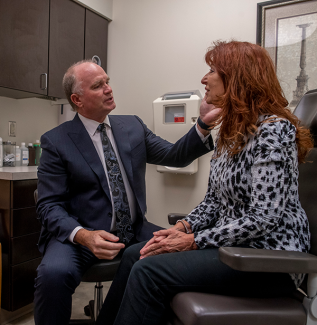What is a mini facelift?
A mini facelift is a modified version of a traditional facelift. It is a cosmetic surgery that targets sagging facial skin. The procedure addresses the lower half of your face. “Mini” aside, a mini facelift is major cosmetic surgery.
A mini facelift is among the specialized cosmetic procedures offered to patients at Wilson Plastic Surgery. Dr. Wesley G. Wilson is a board-certified and highly experienced plastic surgeon who has built a highly-regarded cosmetic medical practice. Dr. Wilson encourages you to schedule a consultation to determine if a mini facelift is right for you.
Benefits of mini facelift
Mini facelift surgery can be very effective at raising and tightening sagging facial skin. The mini facelift technique uses minimal incisions to “lift” your face and remove excess skin. The result is noticeable facial tightening and a reduction of wrinkles. The procedure produces minimal scarring, very few side effects, and quick recovery.
Am I a candidate for a mini facelift?
Generally, yes, if you seek a cosmetic surgery that requires shorter incisions than a traditional facelift. There are virtually no “downsides” to a mini facelift. You should be in good general health. The best candidates for mini facelifts tend to be patients with mild to moderate facial sagging, no more than moderate chin fat, and a well-defined neck and jawline.
Preparing for your mini facelift
Provide your doctor with a complete list of all supplements and medications you are taking. You will be directed to suspend the use of any substance, such as aspirin that can promote excessive bleeding. Non-smokers are always preferred candidates. But if you smoke, you will likely need to stop smoking for about a month before your surgery. Avoid wearing makeup or jewelry to your scheduled ssurgery. It just slows things down! Be sure you have arranged for someone to drive you home after your procedure. Securing a little “help around the house” for a few days after your surgery is also a good idea.
Mini facelift Procedure
Mini facelifts may be performed using local, rather than general, anesthesia. General anesthesia is still widely used for people who don’t want to see or feel anything during the procedure. The surgery begins with your doctor placing small incisions in front of your ears, extending from your hairline to the bottoms of your earlobes. Your surgeon will then manipulate, relocate and lift your skin. Once your procedure is complete, your surgeon will use sutures to close all incisions.
Mini facelift recovery
After your surgery, you will have dressings over your stitches. Your doctor will make an appointment with you to remove your stitches, usually about a week to ten days following your procedure.
While mini facelift procedures require much less recovery time than a traditional facelift, you’re still going to need to take some time off. That said, most mini facelift patients can go back to work about a week after surgery. At that point, any remaining swelling or bruising may be covered with foundation or makeup. Your doctor will likely recommend that you avoid high-intensity workouts or other strenuous physical activity until your bruising and swelling have entirely subsided.
Mini facelift Results
Since a mini facelift is a “scaled back” version, results may not be as long-lasting as those produced in a traditional facelift. But an excellent surgical candidate in the right surgical hands can expect impressive results that can hold up for years.
Keep in mind that mini facelifts can often be combined with non-invasive procedures like dermal fillers or fat grafting to maximize your results.


